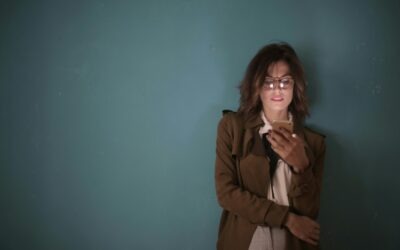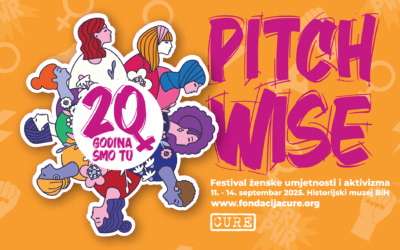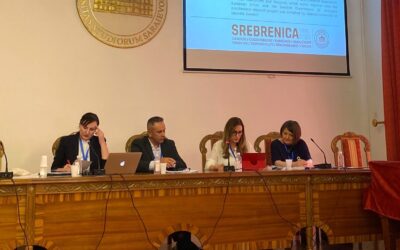Tina Valentan: Calypso
Performance // 50′ // 2016
A performance with ovaries!
Which came first, the chicken or the egg? The egg in the chicken, the chicken in the egg.
In this performance the author’s focus undoubtedly derives from her own experience of motherhood, especially from the difficult coordination between working as an artist and being a mother, as she deals with creativity, potentiality, genesis, production and reproduction. Female reproductive organs, specifically the ovaries as a motive, from which the performance draws, appears to be a good equivalent of that. The performance doesn’t lead women to their reproductive function, but rather questions her position in a place, where the society imposes such perception. (…)
The most powerful scenes to which generally a joyful atmosphere inserts of self-irony, which shows struggle with hardship coordination of both worlds, biological and art (pro)creations. Thus, for example just as Tina has built an atmosphere for meditation, her phone vibrates from a hatched egg – her partner wants her to put their child to sleep as she tells him that she’s right in the middle of her performance. Even more powerful is her confession that one life has been sacrificed or replaced for/with this performance. Eros can be strong and liberating to creation, at the same time in the given circumstances demands a disproportionate amount of sacrifice from women. (…)
– Pia Brezavšček / critic, reviewer and theatrologist
Calypso is ridiculously unimportant and thick-headed. Calypso is goddess. Calypso is a night club for all sorts of males. Calypso unveils new horizons for the entertainment industry by capitalizing on creative sexuality, reassuring you that plain scrap iron can be turned to gold! Calypso (orig. to deceive, to hide) represents individual and collective patterns that are being transmitted invisibly and secretly through space and time, affecting also individual lives.
Thick-headedness proves to be the tool of the elite again and again. Those unknowing of the history don’t know what they are resisting against.
– Andreja Kopač & Tina Valentan
What is an artwork made of? In this performance the answer is obvious but hidden. It is hidden in two golden eggs that travel a long way from barely perceived feeling in the womb to the staged performance. In it, the dancer addresses nothing less than all creation saying: “Welcome to the Peace space station!”
Calypso by Tina Valentan isn’t from Homer yet it is – the same as the immortal nymph Calypso – from a solitary land of shadows. It draws strength from the blackness of its inner universe which carefully forms into a movement and voice and reluctantly reveals secrets to the mortals too soon. What she shares with the mythological Calypso is mainly the name: καλÏπτω (kalyptÅ) is a Greek word for covering or concealing and in the figurative meaning hiding, deceiving but also protection. The care of the self.
Calypso and Calypso: two seducers surrounded by symbols of opulence. They give away their wealth with the generosity of those who have nothing but the awareness that before we break it anything can hatch from the golden egg. All possibilities are open. But Tina Valentan’s Calypso is compelled to choose only one way before breaking the egg. What will come out of it: an artistic or biological miracle? A performance or a child? In her picture of the world, every cell holds the entire cosmos and everything is connected, a tree, a dinosaur and a human – therefore creativity and art and motherhood are not mutually exclusive. But in the world she lives in there is not enough money for both. There’s no place for the diversity that Calypso takes immense pleasure in: an astronaut, a dancer, a cosmonaut, a pop star, a bimbo and mystical visionary all in one.
This is the origin of pain and snarling. Disguising because you can only pick one in such a flattened world. It appears that even the magical power of the golden eggs fails. No matter how Calypso protects and hatches them, they remain speechless. Self-sufficient. She tries in vain to revive the ancient mythopoetic picture of the world as a cosmic egg where everything begins and ends, and where there’s truly plenty of room for everybody. Here and now, Calypso has to transform from a goddess into a pop star, and stuff all her dimensions into an exotic hat. Like a contemporary Carmen Miranda who traded calypso and samba for synthetic rhythms, she dances around and more out of a habit than desire she impertinently flirts with the audience which despite seeing it all still feels embarrassed.
To make matters worse, Calypso removes golden eggs from her eyes from where they move directly to the ovaries and converts from an astronaut-cosmonaut at the Mir space station into an ordinary mortal condemned to biology. But before we sign out in disappointment as her guests, we should look back and forth and remember where the golden eggs came from and where they are going. Do ovaries really direct Calypso or could it be that she directs them? Is this captivity or freedom? What about both at the same time? Mystics nod assent. Baroque poet Angelus Silesius might have wondered which came first, the chicken or the egg, and gave an answer himself: “The egg in the chicken, and the chicken in the egg.” It is not difficult to imagine that in the Piece dance hall, Calypso would cheerfully propose him a toast with egg liqueur and with an extravagant hat on her head call out: “Long live tutti frutti!”
– Tea Hvala / critic and reviewer
Author and Performer: Tina Valentan
Music and Outside Eye: Tian Rotteveel
Dramaturg: Aleksandra Blagojević
Artistic advisory: Snježana Premuš
Costume Designer: Urška Recer
Light Designer: Urška Vohar
Theoretical Reflection: Tea Hvala
Executive Producer: Amela Meštrovac
Production: City of Women
Co-production: Dance Theatre Ljubljana, Dance Room Maribor
Dancer and choreographer Tina Valentan has graduated from the School for New Dance Development in Amsterdam. She has been active in the field of contemporary dance for many years. Over the last years she has been focusing on performing for other choreographers. She is currently touring European dance festivals with Milan Tomášik & Co with performances Hunting Season (2014) and Silver Blue (2015). She is also working closely with Snježana Premuš, a Body Mind Centering practitioner and choreographer, with whom she is expanding her knowledge of the body and co-creating performances, lastly Physical Manifestations (2015). She is also appearing in the children’s performance Doodledee, It’s Me!. After presenting her choreographical debut at the first edition of Platforma Festival in 2007, which she later on developed in an acclaimed solo When the Moon Is Increasing (2008) produced by City of Women, Tina has returned to the stage with her new solo project, which is putting centre stage a woman in possession of her full powers – Calypso. She received a Ksenija Hribar Award in 2017, which is presented by The Contemporary Dance Association Slovenia at Gibanica, Biennial of Slovenian Contemporary Dance Art.













Photos by: Nada Žgank and Almedina Meštrovac
How would you introduce or describe the work you will present at PitchWise 2017?
In the performance Calypso I am working on a connection with my ovaries. I am interested in triggering movement from that specific place. I want to find a relation between my womb and the galactic womb and the womb of the earth, to awaken the creative potential of my sexuality and relate to my cycling nature. I am looking for what is concealed in that part of my body; what kind of energies, forces, colours, feelings, social patterns and cultural behaviours.
What do you know about the women’s movement, and the development of intersectional feminism in Bosnia and Herzegovina?
Nothing but I am curious to learn something about it when I get to the festival.
What similarities can you see in Slovenia and Bosnia and Herzegovina relating to patriarchal culture and the challenges faced by members of marginalized communities? And what do you think our respective communities and organizations can learn from each other through participation in PitchWise 2017?
Here I can just share that I have recently noticed, at one of the Ljubljana’s neighborhoods where many ex Jugoslav nationalities live, that on a sunny Sunday afternoon only men were on the playground. Younger men were playing football and older were playing chess. Women were nowhere to be seen. It made me think of how many patriarchal patterns are still rooted in their culture.
Such festivals like Pitchwise can point out discriminating social behavior and motivate women to express themselves, remind us that nothing is for granted and show us which organisations we can join if we want to influence change.
What kind of reactions has your work, and from whom?
The performance is a reaction to my personal struggle as a mother – artist. Precarious work presents a big challenge for a woman to keep up with her career and take care of her family at the same time. Although it seems like female and male roles are becoming more equal in our society most of the housework responsibilities are still taken care of by a woman. An abortion, which I decided to do after I got pregnant for the second time, made this feeling of being split between family life and career even stronger. Some gender inequalities are historically deeply rooted.
Why do you think it’s important for festivals and events like PitchWise to connect artists and attendees from different countries and regions?
Like this we can develop a common understanding and tolerance towards different gender inequality issues and create a history of social change with more power.


